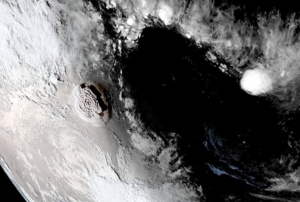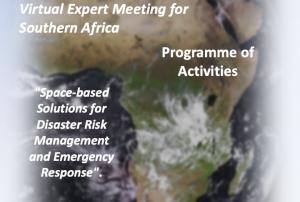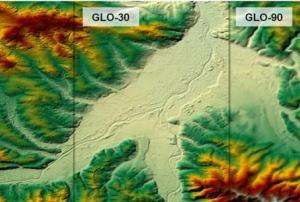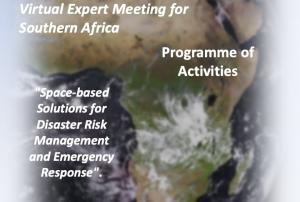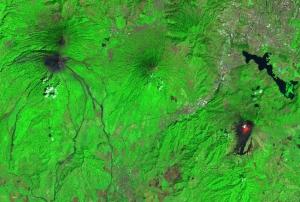Volcanic Eruption
Definition
Facts and figures
Further information
UN-SPIDER Regional Support Offices with hazard-specific expertise
Related content on the Knowledge Portal
Matthew Blackett, Coventry University
The scale of a recent volcano eruption took the people of Tonga by surprise. Scientists monitoring the submarine volcano, Hunga Tonga-Hunga Ha'apai, were likewise caught off-guard, failing to foresee an explosion which would unleash a Pacific-wide tsunami.
The scale of the eruption was hailed as a “once in a millenium” event by one scientist. It hurled gasses and ash over 39km into the atmosphere – comparable to that ejected from Mount Pinatubo in 1991 – and generated a…
read more28/01/2022On the 13th and 15th of January 2022 the underwater volcano on Hunga Tonga-Hunga Ha’pai, located in the South Pacific Kingdom of Tonga erupted. The eruption on the 15th of January 2022 was seven times more powerful than the first eruption of the volcano, which took place on the 20th of December 2021. Additionally, it led to a tidal gauge, resulting in a tsunami wave that impacted countries in the Pacific Ocean, from the Kingdom of Tonga, Australia and New Zealand, Japan, up to Peru, among others, on the other side of the Pacific.
The volcanic eruption was captured by the GOES-West Earth-observing satellite operated by the U.S. National Oceanic and Atmospheric Administration (NOAA), as well as by the Himawari-8 satellite, operated by the Japan Meteorological Agency (JMA), resulting in spectacular images, revealing the large extent of this event.
This is an example of the capacity of geostationary satellites and the benefit of meteorological satellites tracking large…
read more18/01/2021Space-based Solutions for Disaster Risk Management and Emergency Response for Southern Africa
UN-SPIDER and ZFL are holding a regional virtual expert meeting for Southern Africa, a region vulnerable to hydrometeorological, geological, coastal and biological hazards and gravely impacted by droughts in recent years.
The objectives of this regional virtual expert meeting are:
- To raise awareness regarding novel applications of satellite technologies in risk assessment, early warning systems, and disaster response operations;
- To survey and examine efforts carried out by risk and disaster management institutions in Southern African countries on the use of space technologies and space-based information in disaster risk management, preparedness, response and recovery efforts;
- To explore ways to enhance the use space technologies in disaster risk management and response and recovery applications in Southern Africa.…
- The Copernicus DEM is a Digital Surface Model (DSM) which represents the surface of the Earth including buildings, infrastructure, and vegetation. The Copernicus DEM is provided in 3 different instances. Two worldwide coverages at 90m (GLO-90) and 30m (GLO-30) resolution are openly available to the public for download via the PANDA Catalogue and FTP. A further European coverage (EEA-10) is provided at 10m resolution, but data is restricted to eligible users who meet required access rights.Publishing institution:
- The Copernicus DEM is a Digital Surface Model (DSM) which represents the surface of the Earth including buildings, infrastructure, and vegetation. The Copernicus DEM is provided in 3 different instances. Two worldwide coverages at 90m (GLO-90) and 30m (GLO-30) resolution are openly available to the public for download via the PANDA Catalogue and FTP. A further European coverage (EEA-10) is provided at 10m resolution, but data is restricted to eligible users who meet required access rights.Publishing institution:
África del Sur está expuesta a amenazas hidrometeorológicas, geológicas, costeras y biológicas. En los últimos años la región ha sufrido los impactos de sequías, inundaciones y plagas de langosta. La tormenta tropical Idai provocó inundaciones severas en Mozambique, Malawi y Zimbabue en marzo del año 2019 y en el año 2020 varios países tuvieron que afrontar la plaga de langosta. Desafortunadamente, COVID-19 sigue impactando a todos los países de esta región.
Para continuar promoviendo el uso de tecnologías espaciales en actividades relacionadas on la gestión para la reducción de riesgo de desastres, la preparación, la respuesta y la recuperación en caso de desastres, ONU-SPIDER y el Centro de Percepción Remota de Superficies Terrestres de la Universidad de Bonn (ZFL por sus siglas en inglés) unieron esfuerzos para organizar la Reunión Regional Virtual de Expertos para África del Sur: "Soluciones Espaciales para Gestión de Riesgo y Respuesta en caso…
read moreRegional Support Offices mentioned:19/07/2021Southern Africa is exposed to hydrometeorological, geological, coastal and biological hazards. The region has been hard hit by droughts in recent years. Tropical cyclone Idai triggered massive floods in Mozambique, Malawi, and Zimbabwe in March 2019, and in 2020 several countries experience a severe locust outbreak. And unfortunately, COVID-19 continues to impact all countries in this region.
To continue efforts to promote the use of space technologies in disaster risk management, emergency response and recovery efforts, UN-SPIDER and the Centre for Remote Sensing of Land Surfaces of the University of Bonn (ZFL) joined forces to organize the UN-SPIDER / ZFL Regional Virtual Expert Meeting for Southern Africa "Space-based Solutions for Disaster Risk Management and Emergency Response" from 13 to 15 July 2021. This regional expert meeting contributed to the efforts conducted by UN-SPIDER on disaster risk reduction, preparedness, early…
read more19/07/2021In Guatemala there are two volcanoes which have been more active recently: Fuego and Pacaya. These volcanoes pose a prominent threat to the lives of the inhabitants of the highly populated surrounding areas. This threat is evidenced by the 2018 eruption of Fuego, which caused the deaths of nearly 200 people, and the recent activity of Pacaya volcano since the beginning of the year, that has impacted communities located in its foothills, and which forced authorities to close Guatemala's international airport in Guatemala City due to ash fall from its activity.
The two volcanoes were effusive and explosive in early February 2021, according to reports by the Smithsonian Institute Global Volcanism Program and the National Institute of Seismology, Meteorology and Hydrology (INSIVUMEH) of Guatemala. This has resulted in volcanic ash and gas being hurled into the atmosphere, of which fine volcanic ash…
read more14/05/2021- Publishing institution:
- Publishing institution:

